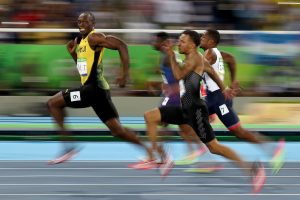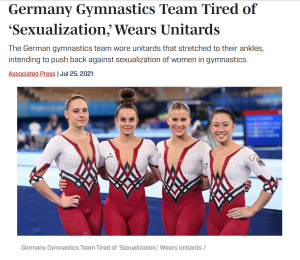1
Section One: The Fundamentals
A) What do we know about sport? What are common assumptions we make about sport and society?
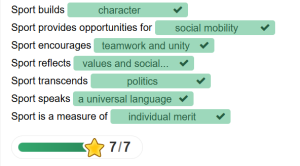
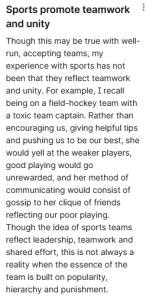 |
Exercise 3: Notebook prompt
What are some other metanarratives about sport that you are familiar with? Find an image or video clip or draw something yourself that captures this idea…
So what? Why does any of this matter? Does it matter? As something we grow up with – live with – play through – we don’t often interrogate the meanings of sport, and perhaps we don’t want to.
But being aware of these assumptions and metanarratives is especially important, I would argue, because of the centrality of sport to our everyday lives, the role that sport plays in shaping our childhood and worldviews and….. [finish that thought]
| Metanarratives that I am familiar with regarding sports is that they are entirely skill-based. For example, the more skill you have in an area of sports or activity, the more highly-regarded and esteemed you are said to be in this sport. This builds self-confidence, self-trust, character and a more dynamic personality.
Because sports build a foundation of confidence and trust in oneself, as well as an improved ability to perform tasks (ex. running), when one displays skill which is recognized and rewarded (ex through a trophy) they will be more likely to continue performing this sport and become more advanced. I believe that being good in sports, especially in childhood, reinforces confidence and self esteem, which carries through to and beyond adulthood in many avenues in life. For example, a child who scored a home run in little-league baseball and wins MVP of the game will likely continue to practice and advance in this sport (and others). Then he will become more confident in himself having proved his skill and worth, thus perhaps also becoming more confident in school, work, relationships, etc. To contrast, a child who fumbles the ball and is chastised by his coach may be less likely to pursue this sport in the long run, have damaged self esteem and be less likely to try new things in the future. |
B) What is social justice?
Exercise 4: Padlet Prompt
Think back to the last section and try to look at some of the ideas we discussed differently. How might sport and social justice actually co-exist?
Record any images, video clips, or gifs you added to the padlet and identify a point of intersection between sport and social justice (can be an issue or a barrier or a debate or something you would like to explore in more depth in this course) . Screenshot or paste in your response below.
| https://www.si.com/olympics/2021/07/25/tokyo-olympics-germany-gymnastics-wears-unitards
Sports and social justice coexist. Moreover, sports provide an excellent opportunity to display, in an interdisciplinary manner, a variety of different methods of promoting social justice or rejecting injustice. In 2021, the Olympic German gymnastics team wore unitards instead of leotards as a method of pushing against the standard of wearing bikini-cut leotards that oftentimes sexualize only women in the sport. Though subtle, this wardrobe evolution was a classy demonstration of fighting for social justice and implementing new innovative strategies for making social change.
|
C) Social Justice Reading
OPTIONAL
D) KINESIOLOGY AND SOCIAL JUSTICE
Exercise 5:
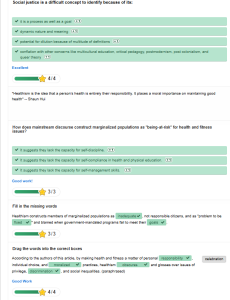
Exercise 6:
What are the implications of bodies-at-risk discourse and the refusal to understand the health gap from a social justice perspective, according to the authors of this article?
| Bodies at Risk describes the tendency for society to target marginalized groups (i.e racially diverse, non-white, non-male) bodies for being “at risk” of not meeting the required standards of being “healthy” or following health norms. These beliefs come from common discourse that white male bodies that are able to perform all tasks are the “standard” and anything that falls short of this image is targeted for being at risk. Neoliberalism, sameness and competitiveness from a Westernized perspective is the driving force towards these beliefs and ideology, creating a constrained and unrealistic image of health. Lastly, the “bodies at risk” framework creates a white patriarchal master framework that reinstitutes post-colonial, westernized discourse that disadvantages many communities. |
Section Two: Sport Feminism
Exercise 7: Notebook Prompt
What is feminism? What does it mean to you? Choose one of the images below and explain how it captures your understanding of feminism (or find one that does speak to you and paste this into your pressbook with an explanation of why it matters to you.
| In my opinion, Rosie the Riveter represents the pinnacle of feminism — the belief that not only can women do anything a man can, but rather we are obligated as members of the human race to fight back when/if we can in times of need. Rosie the Riveter represents propaganda displaying a strong, independent working woman who helps fight for her country’s freedom in WWII. She is strong, fearless and determined, similar to how women are in sports. This image matters to me because it reminds me of how times are constantly changing and feminism is becoming a stronger force by the minute. Additionally, this propaganda was revolutionary for its time in the realm of feminism and reminds me of how feminism and female empowerment should always be exercised and demonstrated in society. |
Exercise 8: Notes Prompt (optional)
OPTIONAL
Exercise 9: Crossword Activity
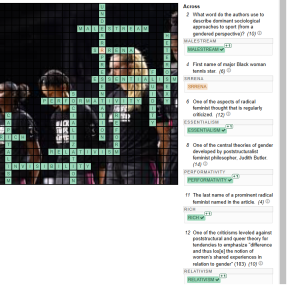 Please ignore the typo, I meant to type Serena!
Please ignore the typo, I meant to type Serena!
Exercise 10: Padlet Prompt
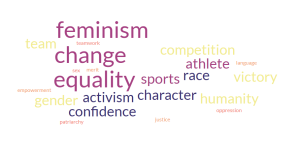 |
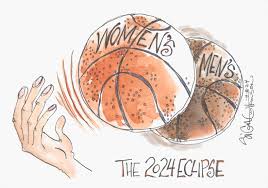
|
|

